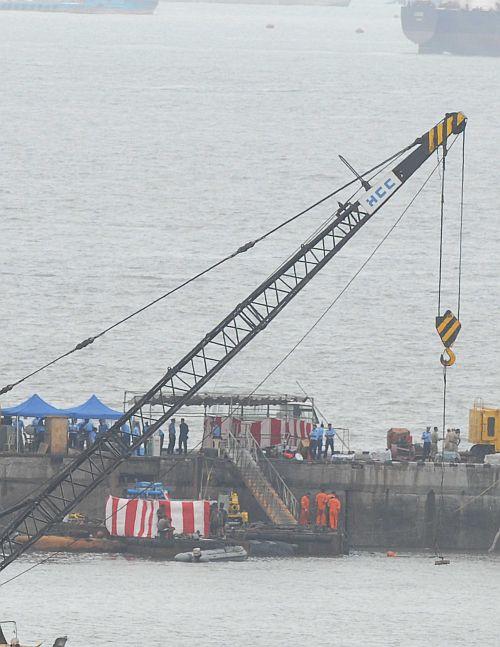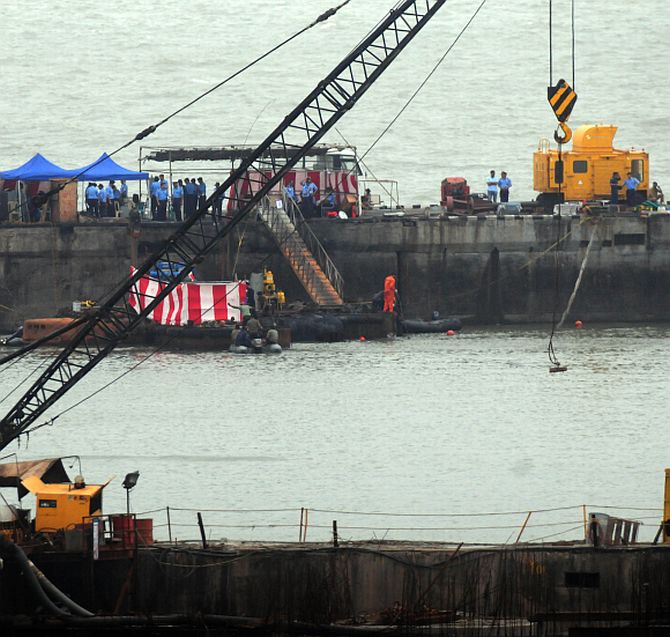Photographs: Sahil Salvi
Facing tough conditions, Indian Navy divers on Friday extricated badly charred bodies of four personnel from submarine Sindhurakshak as hopes of finding survivors receded with naval authorities voicing worst fears that others on board could have been incinerated too.
Two days after a series of explosions rocked the Navy's frontline underwater craft, igniting a massive blaze around Tuesday midnight, only four bodies of the 18 on board the ill-fated submarine, including three officers, have been pulled out since morning.
The "severely disfigured" bodies are so badly charred that on-the-spot identification was impossible, defence spokesman Narendra Vispute said.
More updates on submarine tragedy
..
Hope sinks amidst Sindhurakshak's mangled remains
Image: Salvage operations going on at the dockyardPhotographs: Sahil Salvi
"The damage and the destruction within the submarine around the control room area indicate that the feasibility of locating bodies of the personnel in the forward part of the submarine is also very remote as the explosion and very high temperatures, which melted steel within, would have incinerated the bodies too," a release from the Navy said.
"The state of the bodies and condition within the submarine leads to firm conclusion that finding any surviving personnel within the submarine is unlikely," it said.
Meanwhile, the police have registered a case of accidental death in connection with the worst peacetime tragedy suffered by the Navy. The case has been registered under section 174 CrPC relating to accidental death on the basis of a statement by Gopal Singh Rajput, a doctor attached with Sindhurakshak.
...
Hope sinks amidst Sindhurakshak's mangled remains
Image: Navy divers at the spotPhotographs: Indian Navy
Boiling water inside the submarine had thwarted all attempts by rescuers at entering the ill-fated Russian-made submarine till Wednesday.
The divers from the Navy, who entered the 2,300-tonne vessel through the conning tower, battled heavy odds due to the turbid, muddied water that has entered the submarine after it exploded, jammed hatches which have fused with the body of the craft under intense heat and darkness inside.
"Access to the inner compartments of the submarine was almost impossible due to jammed doors, distorted ladders, oily and muddy water inside the submerged submarine resulting in total darkness and nil visibility even with high powered under water lamps," the release said.
The distorted and twisted metal within very restricted space due to extensive internal damage caused by the explosion further worsened conditions for the divers which resulted in a very slow and laboured progress, it said.
...
Hope sinks amidst Sindhurakshak's mangled remains
Image: Salvage operations going on at the dockyardPhotographs: Sahil Salvi
"The process is very slow but our divers are on the job 24X7," Vispute said, adding officers have been deployed to extend all assistance to the families of the victims.
Efforts were also on to drain accumulated water from the vessel after which efforts would be made to salvage it, he said, adding the focus right now was on locating and extricating the bodies.
The Navy had on Thursday released the names of the three officers and 15 sailors who were inside the 16-year-old vessel.
The three officers are Lieutenant Commanders Nikhilesh Pal, Alok Kumar and R Venkitaraj.
The sailors have been identified as Sanjeev Kumar, K C Upadhyay, Timothy Sinha, Keval Singh, Sunil Kumar, Dasari Prasad, Liju Lawrence, Rajesh Tootika, Amit Singh, Atul Sharma, Vikas, Naruttam Deuri, Malay Haldar, Vishnu V and Sitaram Badapalle.
The Kilo class diesel-electric submarine was commissioned into the Indian Navy in 1997 at a cost of around Rs 400 crore and had gone through a Rs 450-crore upgrade in Russia.
Click on MORE for related news...





article